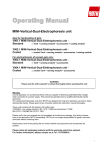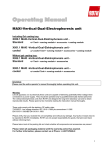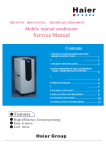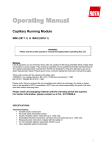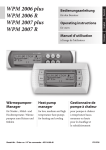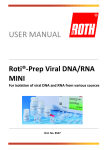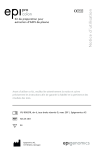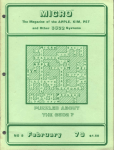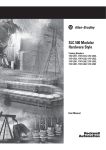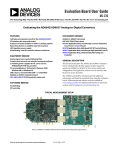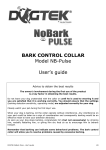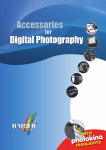Download User manual / Technical Information
Transcript
Rotiphorese® PROclamp MINI Vertical Electrophoresis System Complete set: 3501.1 Rotiphorese® PROclamp MINI with Accessories and Gel Casting Module Tank + running module + accessories + casting module Standard set without casting base: 3502.1 Rotiphorese® PROclamp MINI with Accessories Tank + running module + accessories For precast gels only: 3503.1 Rotiphorese® PROclamp MINI without any Accessories Tank + running module WARNING: Please read the entire operator’s manual thoroughly before operating this unit. Warning: Like all apparatus run by electricity these units are capable of delivering potentially lethal voltage when connected to a power supply. They should be operated only by qualified technically trained personnel. The vertical electrophoresis units from ROTH are designed for long term laboratory use and to obtain reproducible results. Please spend a few moments reading the instruction manual thoroughly. These units comply with the statutory CE safety rules: 73/23/EEC: Low voltage directive: IEC 1010-1:1990 plus amendment 1:1992 EN 61010-1:1993/BS EN 61010-1:1993 Please verify that you received the unit completely and without any damage. Any faults or losses have to be reported to ROTH immediately. ROTH can not accept responsibility for goods that were sent back without informing them. Please take a look at the packing list and check whether all components and accessories are present. Please retain all packaging material until the warranty period has expired. For further information, please contact us at Tel.: 0721/5606-0. 1 SPECIFICATION Technical features User-friendly injection molded construction, 100 % leak-proof Doubly insulated cables, rated safe up to 1000 volts Gold plated electrical connectors, corrosion-free and rated safe up to 1000 volts Recessed power connectors, integral with the safety lid 0.2 mm diameter platinum electrodes, 99,99 % pure User replacable platinum electrodes Silicone rubber dovetail seal provides leak-free sealing and is easy to clean or replace User-friendly clamping system With a wide range of accessories Environmental Conditions This apparatus is intended for indoor use only. The unit can be operated safely at an altitude of 2000 m. The normal operating temperature range is between 4 °C and 65 °C. Maximum relative humidity 80 % for temperatures up to 31°C decreasing linearly to 50 % relative humidity at 40 °C. All Roth products available for delivery have undergone rigorous quality controls. PACKING LIST Content Tank with lid and cables Running module Dummy plate 2.0 mm notched glass plates 2.0 mm glass plates with 1 mm fixed spacers 1 mm combs with 12 teeth Cooling set Casting module Screws for optional use 3501.1 (complete) 1 1 1 2 2 3502.1 (standard) 1 1 1 2 2 3503.1 (for precast gels) 1 1 1 - 2 1 1 4 2 1 4 1 4 Available Accessories (All accessories can be purchased from Carl Roth GmbH + Co. KG. Please use the indicated ordering numbers. Additional reagents and accessories can be found in top K.) Tank (without lid) Replacement lid for tank Running module Casting module Replacement rubber mat for casting module (2 per set) Cooling Set Replacement platin electrode (Ø 0,2 mm) Gel Multi Caster for 6 gels Gel Multi Caster for 12 gels Standard glass plates Notched glass plates Dummy plate Glass plates with spacers (0.5 mm) Glass plates with spacers (0.75 mm) Glass plates with spacers (1 mm) Glass plates with spacers (1.5 mm) 3509.1 3511.1 3504.1 3506.1 3507.1 3512.1 T794.1 3117.1 3118.1 (two plates) 3528.1 (two plates) 3522.1 (two plates) 3520.1 (two plates) 3531.1 (two plates) 3537.1 (two plates) 3542.1 (two plates) 3547.1 2 Glass plates with spacers (2 mm) Notched glass plates with spacers (0.5 mm) Notched glass plates with spacers (0.75 mm) Notched glass plates with spacers (1 mm) Notched glass plates with spacers (1.5 mm) Notched glass plates with spacers (2 mm) Spacers (0.5 mm) Spacers (0.75 mm) Spacers (1 mm) Spacers (1.5 mm) Spacers (2 mm) (two plates) (two plates) (two plates) (two plates) (two plates) (two plates) (pair) (pair) (pair) (pair) (pair) 3548.1 3552.1 3561.1 3563.1 3567.1 3568.1 3570.1 3573.1 3578.1 3579.1 3584.1 Combs 1+1 325 µl 500 µl 650 µl 1000 µl 1300 µl 0.5 mm 0.75 mm 1.0 mm 1.5 mm 2.0 mm Max. sample volume per well 5 8 10 12 50 µl 30 µl 20 µl 18 µl 70 µl 40 µl 30 µl 25 µl 100 µl 60 µl 40 µl 35 µl 140 µl 80 µl 60 µl 50 µl 200 µl 120 µl 80 µl 70 µl 16 13 µl 20 µl 25 µl 40 µl 50 µl Wells 1+1 5 8 10 12 16 Thickness Art. No. Art. No. Art. No. Art. No. Art. No. Art. No. 0.5 mm 3585.1** 3587.1 3593.1 3595.1* 3597.1 3598.1* 0.75 mm 3600.1** 3605.1 3606.1 3610.1* 3612.1 3614.1* 1.0 mm 3622.1** 3632.1 3632.1 3633.1* 3638.1 3640.1* 1.5 mm 3642.1** 3644.1 3649.1 3656.1* 3657.1 3658.1* 2.0 mm 3662.1** 3664.1 3665.1 3667.1* 3668.1 3672.1* *Compatible with multi-channel pipettor ** Combs for preparative gels 20 10 µl 15 µl 20 µl 30 µl 40 µl 20 Art. No. 3599.1 3615.1 3641.1 3659.1 3674.1 Tab. 1 Operational for 1 mm thick gels upper tank 100 ml 100 ml Buffer vol. lower tank 250 ml (no cooling) 1000 ml (using cool pack) Voltage (V) maximal 225 V recommended 100 – 150 V (10 – 15 V/cm) Approx. Gel volume 7.5 ml Current (mA) recommended maximal 10 – 15 mA 25 – 45 mA (1 Gel) 40 – 90 mA (2 Gels) 3 USING THE VERTICAL GEL ELECTROPHORESIS UNITS A. Safety Precautions Please read the entire instruction manual thoroughly before using the apparatus. Always isolate electrophoresis units from their power supply before removing the safety cover. Isolate the power supply from the mains first then disconnect the leads. Do not exceed the maximum operating voltage or current (see table 1). Acrylamide is a volatile, concentrated neurotoxin which is suspected to be carcinogenic. Please always wear protective clothing when working with acrylamide and follow and observe the working instructions / directions for disposal carefully. Polymerized gels contain residue of unpolymerized monomer. Please wear always protective gloves while working. Do not fill the unit with running buffer above the maximum fill lines. Do not move the unit when it is running. CAUTION: During electrophoresis very low quantities of various gases are produced at the electrodes. The type of gas produced depends on the composition of the buffer employed. To disperse these gases make sure that the apparatus is run in a well ventilated area. B. General Care and Maintenance Clean the apparatus with hand warm water and a mild detergent only. Often, a thorough rinse with distilled water is all that is required. Dry components with clean tissues prior to use, e.g. ROTH tissues (ref. 0087.1) Important: Acrylic plastic is not resistant to aromatic or halogenated hydrocarbons, ketones, esters, alcohols (over 25 %) and acids (over 25 %), they will cause „crazing“of the plastic and should not be used for cleaning. Do not use abrasive creams or scourers. The units should never come into contact with the following cleaning agents, these will cause irreversible and accumulative damage: Acetone, Phenol, Chloroform, Carbon tetrachloride, Methanol, Ethanol, Isopropyl alcohol, Alkalis. Before use, and then on a monthly basis, check the unit for any leaks at the bonded joints. Place the unit on a sheet of dry tissue and then fill with distilled water only to the maximum fill line. If any leakage is seen do not attempt to repair or use the apparatus, but notify Carl Roth GmbH & Co. KG immediately (+49/0721/5606-172). The replacement platinum electrodes are partially shrouded for protection. However, when cleaning the main tank do not use cleaning brushes in the electrode area. Ensure that the connectors are clean and dry before usage or storage. C. RNase Decontamination Clean the units with a mild detergent as described above. Wash with 3% hydrogen peroxide (H2O2) for 10 minutes. Rinsed with 0.1% DEPC- (diethyl pyrocarbonate) treated distilled water, Caution: DEPC is a suspected carcinogen. Always take the necessary precautions when using. Roti®-Nucleic Acid free (Art. No. HP69) and RNAse AWAY(TM) (Art. No. A998) may also be used. Please consult the instructions for use with acrylic gel tanks. 4 D. Fitting Electrode Cables. 1. Note the position of the lid on the unit. This shows the correct polarity and the correct orientation of the cables, black is negative and red positive. 2. Remove the lid from the unit. Note if the lid is not removed, fitting the cables may result in untightening of the gold plug and damage to the electrode. 3. Screw the cables into the tapped holes as fully as possible so that there is no gap between the lid and the leading edge of the cable fitting. 4. Refit the lid. E. Preparing the gel plates 1. Wash the glass plates, spacer and combs with a mild detergent (e.g. washing-up liquid). Do not use a scouring agent. For gels which require an extremely clean surface (e.g. large or very thin gels, silver staining) you can follow up by washing the glass plates with ethanol, acetone and ethanol again. 2. If required, the glass plates can be hydrosiliconed by vaporizing them with di-Methyldichloro-hydrosilicon for easier separation of plate from gel after gel run. 3. We recommend that you only touch the glass plates with gloves (finger prints can be removed with acetone). F. Assembly of glass plates 1. Lay the clean glass plates with the bonded spacers upwards on a flat, clean base. Then place the likewise clean, notched plates on top. If standard glass plates without bonded spacers are being used, the spacers should be placed along the outer edges of the sides of the plates and notched plates laid on top. Be sure to arrange the glass plates in such a way that the mattfinished sides will be at the lower edge of the gel. NOTE: The glass plates with bonded spacers have an arrow in the top of the spacers which are slightly longer than the glass plate to indicate the top. Fig.1 Assembly of glass plates 2. The Slab Gel Insert contains pressure bars which impart even pressure onto the glass plates and allow even screw pressure transfer onto the sealing edge of the glass plate, ensuring complete sealing. Ensure that the pressure bars are adequately open for the thickness of spacer used. The bar can be opened by loosening the screws or by sliding the clamps. When using a triple glass plate sandwich, the pressure bars will need to be in the completely open position 3. Position the Slab Gel Insert on a flat surface. Do not at this stage insert the Slab Gel Insert into the casting base. 4. Slide both gates outwards until fully tightened. When only one gel is being run, the dummy plate must be used in the second position and fully tightened. At this stage, check that the bottom edges of the spacers and glass plates are perfectly aligned. 5. Position the Slab Gel Insert in the casting base such that the Cam pins have handles pointing downwards and are located in the insert holes. The top of the gel rumming module may need to be pushed down very slightly to locate the cam pins. 6. With the cam pin handles facing directly downwards, turn the cam pins fully through 1800 or until the insert has tightened onto the silicone mat. It is best to turn the cams in opposite directions to each other. Do not overturn as this will cause the glass plates to push upwards and the assembly will be more likely to leak. The unit is now ready for gel preparation and pouring. 5 7. Always reverse the silicone mat after casting to avoid indentations from persisting. Never leave the casting up-stand with glass plates tightened into the casting base for long periods of time as this will also cause indentations in the silicone mat. 8. The PROclamp MINI vertical unit also includes screws. This system can be used either with the slide clamps or screws as preferred by the user. For those that prefer to use the screws rather than clamps, the screws can be simply inserted into the screw holes. The clamps can be removed by placing each clamp in the fully open position and gently bending the clamp upwards from the slanted end. The holding pin will then slowly release and the clamp can be removed. G. Casting the gel 1. For reproducible results and for your safety, we recommend using acrylamide stock solutions(e.g. Rotiphorese® Gel 30, Rotiphorese® Gel 40; further acrylamide stock solutions can be found in the main Roth catalogue). Acrylamide solutions should be stored in a cool, dark place (refrigerator). For casting the gels, the solutions should have room temperature, but make sure to only warm the aliquot needed for the gel(s). Avoid exposure to heat and sun. 2. Separation of proteins. For a 12 % gel, size 10 x 10 cm, prepare a total of 30 ml mixture in a clean glass: 12 ml of 30 % acrylamide stock solution, 7.5 ml Tris (1.5 M, pH 8.8), 300 μl SDS (10 %), distilled water to make up 30 ml. Add the following directly before casting: 300 μl freshly prepared ammonium persulfate (10 %), 12 μl TEMED. Separation of DNA. For a 12 % gel, size 10 x 10 cm, prepare a total of 30 ml mixture in a clean glass: 12 ml of 30 % acrylamide stock solution, 6 ml 5 x TBE, distilled water to make up 30 ml. Add the following directly before casting: 210 μl freshly prepared ammonium persulfate (10 %), 12 μl TEMED. Mix carefully avoiding the formation of air bubbles. 3. Test a small amount in an extra vessel before casting the gel. Polymerization should take place within 5 – 10 mins. If this is not the case, adapt the conditions by either increasing or decreasing the TEMED amount. Do not cast gels in direct sunlight. 4. The gel casting can be carried out directly in the gel casting module or in the Multi Gel Casters. Pour the mixture slowly between the glass plates. Avoid the formation of air bubbles. 5. If you wish to cast a two-phase gel (stacking gel and resolution gel), first cast the resolution gel up to approx. 2 cm below the edge of the indentation in the notched plate. Remove any air bubbles from the gel with a comb and then carefully cover the resolution gel 3-5 mm high with isopropanol. Polymerization is improved by excluding all air. 6. Following polymerization of the resolution gel pour off the isopropanol. Absorb remnants of isopropanol with kim wipes, while carefully avoiding to touch the gel surface. Rinse the upper rim of the separation gel with distilled water and remove aqueous remnants. 7. Optional: Prepare and pour the stacking gel, carefully avoiding the formation of air bubbles. Stacking gels are usually composed of 5 % acrylamide. Prepare a total of 5 ml mixture in a clean glass: 830 μl of 30 % acrylamide stock solution, 630 μl Tris (1 M, pH 6.8), 50 μl SDS (10 %), distilled water to make up 5 ml. Add the following directly before casting: 50 μl freshly prepared ammonium persulfate (10 %), 5 μl TEMED. 8. Insert a comb between the gel plates before the gel polymerizes, and allow the acrylamide solution to complete polymerize. Attention: Push the comb slowly! Avoid any splashing of the acrylamide! Wear eye protection for this step! 9. The gel can be used as soon as the stacking gel is polymerized. Remove the pins from the gel casting device and take out the running module including the cast gels. For gel runs: Do NOT open the clamps of the running module, but straightforward place the assembly into the tank. For storage: Carefully open the clamps. Wrap the slightly damp gel in cling foil and store it at 4 °C for 2 days in maximum. 6 H. Gel and buffer volumes / Conditions for the gel run / Cooling If you are only working with one gel, please insert a dummy plate on the other side of the running module. Pour app. 1 l running buffer into the outer (lower) and app. 100 ml running buffer into the inner (upper) buffer tank. Running buffer for protein gels: Tris-glycine-buffer: (25 mM Tris-base, 250 mM glycine (pH 8.3), 0.1 % SDS), running buffer for DNA-gels: 1 x TBE. Recommendations for working conditions are given in Table 1, the conditions vary, however, depending on the gel amount, its composition, and the cross-linking grade of polyacrylamide. The required current increases proportionally to the gel amount or thickness, provided it’s not limited by the voltage. For example, two gels require twice the amount of current compared to one gel at the same voltage. By increasing the gel concentration, the electric resistance is also increased and as a result the velocity of migration is reduced. Higher voltages can be fed, however, please take care that the gel is not overheated. Conductivity of gels with non-dissociated buffer systems varies enormously and conditions must be determined empirically. If desired, fit the cooling pack(s) into the end of the tank. These should be pre-frozen and fitted with the longest side positioned sideways with the end(s) of the tank and pressed into the recess. Or these can be fitted down the front of the tank. If the cool set is used, lower buffer volume has to be increased to 1000 ml in minimum. Please note: Never fit the cool packs underneath the module in the bottom of the tank as this will prevent the flow of current through the gel and cause slow runs and over-heating. The run conditions are to be taken as a guideline only and apply to SDS Tris-glycine gels. If the plates become hot increase the water flow rates within the recommended limits or reduce the power settings. l. Sample application 1. Carefully remove the sample comb and immediately rinse the slots with a syringe or plastic Pasteur pipette filled with running buffer. No forerun is necessary when running denatured SDS mini gels. When running native protein gels or DNA gels, allow these to run first for app. 30 min in the unit before applying samples. Table 2 shows the protein amounts which can be applied and successfully separated. 2. Mix the protein samples with 1/3 volume Roti-Load 4 x (SDS-running buffer) or resuspend the pellet in app. 20 μl 1 x Roti-Load. Heat the sample for 3 min to 100 °C or for 5 min to 80 °C. Centrifuge for 5 min at 12000 g. DNA is mixed with 1/5 volume 6 x sample buffer (e.g. 6 x RotiLoad DNA), pelleted DNA is resuspended in 1 x sample buffer (e.g. 1 x Roti-Load DNA). Tab. 2 Gel wells 1 mm x 4 mm 1.5 mm x 4 mm Single band 1-6 µg Numerous bands 30-60 µg Sample volume <40 µl 1-10 µg 50-100 µg <60 µl 3. Apply the samples using a pipettor with gel loading tip. Avoid the sediment at the bottom of the tube. The pipettor tip should be held 1-2 mm above the base of the recess during sample application to minimize dilution of sample and to apply a thick layer of sample. Fill the unused slots with the same volume of 1 x sample buffer to receive constant electric resistance over the gel. Close the safety lid tightly to ensure that the electric connectors are in good contact. 4. Link the electrophoresis chamber with the Power Supply and connect the latter to the current. Set the Power Supply at the required values (also see table 1) according to the gel run. 7 J. At the End of the Run 1. Turn the power supply settings to zero, turn off the Power Supply and disconnect the power leads. 2. Remove the safety lid by pressing against the tank from the top and take off the lid. 3. Remove the running module from the tank and pour the buffer from the upper buffer chamber. Loosen the clamps carefully and remove the gel(s). 4. Separate the glas plates with a broad, stiff blade beginning at the bottom of the gel. 5. Carefully transfer the gel to a staining chamber and stain with Giemsa (e.g. Roti®-Blue A152) or via silver staining. Alternativaly transfer the gel onto a membrane for blotting. DNA-gels can be stained with ethidium bromide. 6. After removing the gel, clean the plates thoroughly and rinse in distilled water. A clean sheet of foam rubber placed at the bottom of the sink serves as a usual support and minimises the risk of glass plate damage. 7. Drain the lower buffer chamber using a vaccum pump or pour off the buffer carefully. 8. Rinse the chambers with distilled water, then dry the unit according to the instructions given in B. Ensure that the connectors are clean and dry before usage or storage. K. Additional Items and Reagents Acetone, >99.5%, for synthesis Ammonium persulfate (APS) Clamps Disinfectant, neutral Ethanol 70%, DAB Ethidium bromide Ethidium bromide solution 1% Filter papers Giemsa-protein staining solution Roti®-Blue Isopropanol Levelling table Roti®-Load 1, 6 x (reducing) Roti®-Load 2, 6 x (non-reducing) Roti®-Load DNA 1 x (with glycerol) Roti®-Load DNA 6x (with saccarose / glycerol / ficoll) Roti®-Mark 10-150 Roti®-Mark PRESTAINED Roti®-Mark STANDARD Roti®-Red fluorescent staining solution Rotilabo®-clips Rotiphorese®-Blue Rotiphorese®-Gel 30 or 40 Rotiphorese® 10 x SDS PAGE ready-to-use running buffer Silver staining Roti®-Black N (DNA) Silver staining Roti®-Black P (Protein) Silver staining/Bleaching Roti®-Bleach Sodium azide TEMED Zinc staining for protein gels, Roti®-White 5025 9592 e.g. 1589 oder 0566 K354 7301 7870 2218 4926 A152 6752 N854 K929 K930 0100 T847 / X904 / X905 T850 T852 T851 1045 0827 A152 3029 oder 3030 3060 N769 L533 N766 K305 2367 K063 8 L. Trouble shooting and tips The gel leaks during casting. - Please ensure that the glass plates and spacers are clean and there are no dirt particles sticking to them. - Take care that the gel plates are flush to the lower edge of the running module after clamping. - Please also make sure that the clamps and the pins of the casting module have been tightened evenly. - Apply some vaseline to the spacers before assembling the gel plates. - Seal the bottom of the gel with agarose after fixing the gel plates into the running module and gel casting device. For this prepare 1% agarose in 375 mM Tris, pH 8.8 (protein gels) or 1 x TBE (DNA-gels) by melting until no more streaks are visible. Tilt the gel casting device with the plates and allow some of the hot agarose to run down inside on one side of the gel. Place the gel casting device upright so that the agarose can spread on the bottom and form a sealing. You can fill the agarose to a height of app. 5 mm and then cast the polyacrylamide gel a few minutes later. The agarose needn’t be removed prior to the run, but remains between the plates during the run. - Before pouring the gels, the bottom end of the plate assembly can be taped with packing tape. Fasten the plates together after assembling them with strong clamps and stick a strip of broad packing tape lengthwise to the lower edge of the glass plates to close the slit. The tape should overlap a few centimeters on both sides. After folding and sticking the tape onto the glass plates it should be pressed down firmly. The glass plates can now be fixed for casting the gel into the running module and gel casting device. After the gel has polymerized, the packing tape must be removed before the gel can be fixed again and prepared for the run. Air bubbles in the gel during casting - Either remove bubbles immediately with a thin spacer or tilt the gel slightly and knock the air bubbles down to the edge. The gel doesn’t polymerize entirely - Can occur due to low temperatures, too low amounts of TEMED, too old (degraded) TEMED, too old APS or too low acrylamide concentration. Use fresh solutions, particularly freshly prepared APS. Keep all other solutions in the refrigerator. Degas the gel solution before use. Gel doesn’t run / no air bubbles on the electrodes - Check all connections, contact pnotcheds and switches. Take care that the level of the upper buffer covers the indentation of the notched plate. Glass plates are cracked after the run or break during the run - The gel was subjected to too much tension. Don’t tighten the screws so firmly. Take care that the pressure on all screws is increased slowly and evenly. Reduce the voltage during the run. The gel won’t get quite so hot. Gel edge pulled up to top, “Smiling” - Gel temperature was not distributed evenly. Reduce the voltage during the run, increase the cooling. Be sure to fill empty wells with sample buffer. Vertical smears in the bands - Possibly there were dirt particles in the gel mix. Use Roth acrylamide stock solutions, making sure that the gel solution is prepared in clean glass containers. The solution can be filtered and degassed before adding APS and TEMED. - The sample was not centrifuged before applying or sediment was also applied. - Too much protein was applied. Dilute the sample. - Reduce the voltage during the run. Bands are horizontally smudged - Is caused by diffusion of the sample prior to the run. Apply probes more quickly and then carry out the run immediately. 9 Bands are diffuse - Too large protein amounts for too small wells, or gel is too thin. Apply less protein. - Too high a voltage reduces the running time, but results in a poorer separation of proteins. Reduce the voltage during the run. - With DNA-gels: Use the same mixture 5 x TBE to prepare the gel and the running buffer. Slight variations in the concentration can impair separation considerably. Carl Roth GmbH + Co. KG Schoemperlenstraße 3-5 76185 Karlsruhe Postfach 100121 76231 Karlsruhe Telefon: +49 (0) 721/ 5606-0 Telefax: +49 (0) 721/ 5606-149 E-mail: [email protected] Internet: www.carlroth.com e.d. 11/2014 10










